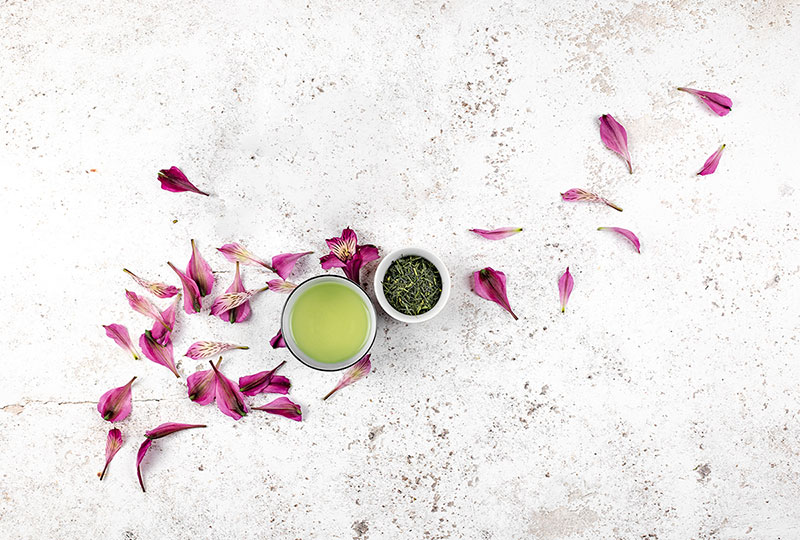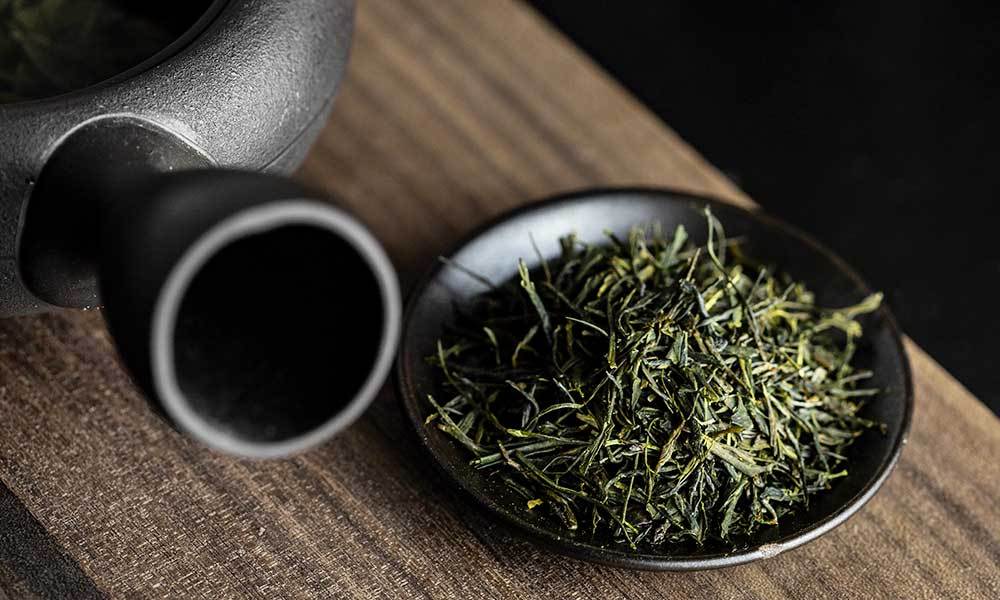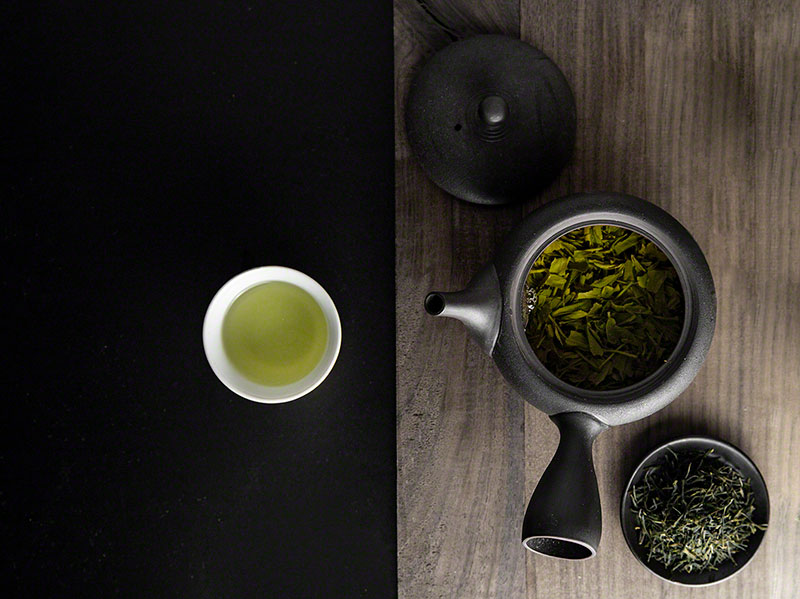Japanese Sencha Green Tea Guide: Benefits, Caffeine, Flavor, etc.

Japanese sencha is one of the most important and popular green teas in the world. If offers a great insight into the world of green teas, it can be brewed to fit everyone’s taste and ma provide a whole range of benefits.
Although many teas use sencha tea as a base for creating delicious flavors, that sencha is usually different from the greener and more refreshing Japanese type. Sencha is a perfect summer tea because it’s light, refreshing, and great for instant cooling. It makes a perfect cup of iced tea too.
Learn how Japanese sencha is made, what is the most popular sencha cultivar, what are the potential benefits and how to brew it for the best taste.
Japanese Sencha Green Tea FAQ
What is Japanese Sencha tea?
Japanese sencha tea is the most popular Japanese tea. Unlike other countries, Japan produces mostly green tea, with sencha being the top tea. Almost 60%[1] of all tea produced in Japan is sencha and most of it never leaves the country. Sencha is made from cultivated tea bushes of Camellia sinensis var Sinensis. Most of the sencha is still non-organic. The upper leaves and buds are harvested for making sencha, and the lower more mature are usually used for bancha.
What does Sencha green tea taste like?
Unlike Chinese teas, almost all Japanese teas are steamed, rather than pan-fired. That’s why they have a fresher, grassier flavor, rather than nutty and sweet notes commonly found in Chinese tea. Sencha green tea can have a range of flavors including grass, sweet, astringent, spinach, kiwi, brussel sprouts, kale, and even butternut notes. Color ranges from very light green to yellow and deep and vibrant emerald green. Depending on how you brew it, it can be more or less astringent with a sweet aftertaste and pronounced savory note.
How much caffeine is in Sencha green tea?
All real teas contain caffeine, even white and oolong. Sencha green tea will usually have around 20-30 mg of caffeine per cup, an average amount for green tea. Depending on other factors such as growing methods, harvesting time and processing, that amount may be lower or higher. For example, younger leaves and buds contain more caffeine than older mature leaves. Roasting can reduce the amount of caffeine in tea and shading will increase it. Therefore, a fresh unroasted green tea made of younger leaves will usually have higher levels of caffeine.
To the first time drinker Japanese green teas like sencha and gyokuro might give a lot more energy than some other green tea types or flavored teas. Therefore, we recommend starting with one cup first to see how you will react. Try to avoid sencha right before sleep.
Does sencha green tea help with weight loss?
Being a green tea with high levels of EGCG, sencha may help you with weight loss goals. Japanese green teas usually contain the highest level of catechins. Although specific teas from other countries may have more catechins, the exact numbers are rarely known. In Japanese sencha the levels are usually consistent. In fact, Japanese sencha might have more catechins than matcha, but they will never be fully extracted into your cup. This brings into focus powdered sencha tea. You can ground your own tea at home, but make sure it’s fresh, safe and tasty. By drinking powdered tea you are ingesting all nutrients, good or bad. Therefore, knowing your tea is very important.
Green tea will very likely provide most benefits if you are a regular tea drinker and drink 3-5 cups of tea per day. Making exercise a part of your lifestyle is very important if you wish to lose weight, with or without the help of tea. Studies say that green tea might increase fat burning rate during moderate exercise. However, scientists still have a long way to go to prove how exactly may green tea actually helps.
Is sencha Japanese green tea?
Yes, sencha is a Japanese green tea, however, Chinese sencha is available too. Although they share a name, those two teas will be quite different in flavor. Chinese sencha is most commonly used for making flavored tea because the flavor matches other ingredients perfectly. On the other hand, Japanese sencha is more grassy and usually enjoyed unflavored and unscented.
How is Sencha green tea produced?
Green tea production has a few main steps. Growing, harvesting, processing, blending and packaging. Tea bushes are usually cultivated from cuttings and grown in neatly arranged rows. Leaves are harvested in spring, summer, and fall, either by hand or machine. Tea leaves for sencha are generally not withered. They are steamed to stop the oxidation process, rolled and dried. This creates a raw or crude tea aracha. To become sencha, producers need to refine aracha. Refining includes sorting and reducing moisture.
What are the sencha tea types?
Japanese sencha is the most versatile tea in type in the world. It can range from subtle to a stronger flavor, with more or less astringency, light yellow to vibrant green color and very sweet aftertaste.
Sencha can be described by a few words:
- Name of the sencha production area
- Harvesting season
- Processing step
- Steaming time
- Cultivar name
- Blending
The most common and regular sencha is unshaded and made from Yabukita cultivar.
1. Production area
Sencha can have the name of the region in its name. The biggest producers of sencha green tea in Japan are Shizuoka, Kagoshima, and Miyazaki regions. Other regions like Fukuoka, Mie, and Saitama are producing sencha too, but the yearly output is lower than in the main regions.
2. Harvesting season
Sencha can be harvested in spring, summer, and fall. The first sencha of the year is called shincha, and it’s popular for a very refreshing and sweet flavor. Shincha literally means “new tea” and it should always be fresh and produced from the very first spring leaves.
3. Processing
Sencha is usually a very uniformed tea, with nicely shaped thin needle-like leaves. However, sometimes you can also buy aracha or unrefined tea. Aracha is messier in appearance and contains steams and veins that are removed in the final stage of processing before tea is sold. Although it has a less refined, less sophisticated look, the flavor is still very refreshing and delicious, but with a bit more rawness. Sencha is sometimes withered too, although rarely. Withering increases fruity and floral flavors, uncommon for Japanese sencha, but common for lightly oxidized oolong tea.
4. Steaming time
The main step in producing sencha is steaming. Leaves are steamed to stop the oxidation and preserve the color, flavor and nutrients. Sencha can be divided into three main types: asamushi, chuumushi, and fukamushi.
Asamushi sencha
Asamushi is a lightly steamed tea, usually for 20-30 seconds. Leaves are bright, unbroken and look very clean. The brewed tea is also very clear, bright yellowish-green and delicate.
Chuumushi sencha
Chuumushi is a medium-steamed sencha, usually around 30-60 seconds. Sometimes it can be difficult to recognize this type of sencha because leaves can look both less or more steamed.
Fukamushi sencha
Fukamushi Sencha is steamed for at least 60 seconds. The subcategory is tokumushi sencha, steamed over 2 minutes. Fukamushi sencha has a very deep, dark green color, with silky-looking leaves, usually very broken. Tea will be enticingly green, often with little particles floating at the bottom.
5. Cultivar name
The most commonly used cultivar for making sencha green tea is Yabukita. Japan uses over 100 cultivars for making different teas, and most of them are suitable for making sencha. All of them have different qualities. Some might give greener color while others are more pest-resistant. Experienced tea drinkers may tell the cultivar from looking at the leaves, checking the color and recognizing small flavor nuances.
6. Blending
The final tea may contain different cultivars blended to achieve specific flavors. Some producers sell only single origin teas, while others blend different types until satisfied with the flavor profile. Neither is better nor worse and which you prefer will depend purely on your taste preferences.

What are other types of sencha green tea and teas similar to sencha?
By-products of sencha production can be used for making other types of tea. They will probably be less expensive, but of the very similar flavor as the original sencha tea. Some other tea types undergo the same production process as sencha, but are shaded before the tea is harvested, such as gyokuro and kabusecha.
Gyokuro
Gyokuro is a rare and exception Japanese green tea with a very distinctive flavor often described as savory and sweet. Shading tea bushes for about 20 days before harvesting raises the level of amino acids and creates umami or a savory flavor. After plucking, tea leaves go through the same production process as sencha. Gyokuro is brewed with temperatures around 122 °F.
Kabusecha
Kabusecha is a special Japanese green tea in-between gyokuro and sencha. It’s shaded for about a week before harvesting. It’s refreshing but sweeter than regular sencha. Sencha can also be shaded for a few days before harvesting too, to develop a stronger savory and sweet flavor popular in gyokuro.
Mecha
Mecha is a type of Japanese tea made from quality sencha or gyokuro buds. Therefore, even though the leaves are very tiny and basically a by-product, their quality is high.
Konacha
Konacha or a sushi bar tea is a green tea type that’s actually a tea production leftover. It contains tea dust, buds, and small broken leaf particles. It can be of very high quality.
Powdered sencha
Powdered sencha is different from matcha, popular powdered tea. Matcha is shaded for at least 3-4 weeks, de-veined and de-steamed, and ground to a very fine silky powder, while sencha is made from the full leaf and has bigger powder particles. The benefits of powdered sencha may be greater than those of loose leaf tea. Drinking the full leaf allows you to get all nutrients from the leaf.
Matcha-iri sencha
Sencha blended with matcha tea powder created another unique tea – matcha-iri sencha. The first infusion has a more pronounced sweet and savory flavor. You can try making this tea at home by blending Japanese sencha with a bit of matcha.
Genmaicha
Genmaicha or “popcorn tea” consists of roasted rice and either bancha or sencha.
Kukicha
Kukicha is a unique type of tea that contains only stems and twigs from gyokuro or sencha, but it may contain some leaf particles too. It’s a low caffeine green tea more suitable for evenings and very popular in macrobiotics.
Tamaryokucha
Tamaryokucha is a very similar tea to sencha, with one big difference. Tea leaves are small and curly, instead of thin and needle-like. Taste is similar, although not the same.
Benefits of Sencha Green Tea
Regular sencha is a staple tea in Japan. It’s possible that tea consumption and healthier eating and exercising habits are responsible for longer life-expectancy and better quality of life. However, any tea that you don’t really enjoy might bring you more harm than benefits. To get the most benefits from green tea you should pay attention to the brewing method, use fresh and properly stored quality tea and make tea a part of your lifestyle.
Green tea has been the subject of many studies. The benefits of green tea come from antioxidants. Antioxidants can fight free radicals and decrease oxidative stress. Every green tea contains antioxidants. Depending on the type, levels can be extremely low or very high. A study published last year says that tea from Japan might have more catechins than green tea from other countries[2]. Another study suggests that sencha infusion has the highest content of EGCg than other Japanese teas.[3] In fact, sencha has more antioxidants than more expensive gyokuro and matcha tea [4].
Potential benefits of sencha green tea include:
- anti-cancer properties
- aiding weight-loss
- anti-aging properties
- prevention of neurodegenerative diseases
- anti-inflammatory properties
- lowering bad cholesterol
- anti-bacterial properties
- prevention of some bacterial and virus infections
- preventing tooth decay
How to Brew Japanese Sencha Tea
Depending on how you brew your sencha green tea, you will either get a very delicate and refreshing, or a very bitter tea. There are a few ways of brewing sencha, a more complicated proper way, or simplified method you can use for everyday brewing.
The proper way of brewing sencha
In Japan, sencha has its own tea ceremony, a sencha-do that follows rules of brewing, serving and enjoying the tea. For a proper simplified everyday brewing, you will need a Japanese teapot kyusu, small sencha cups and a kettle. Kyusu teapots have a fine mesh or ceramic strainers suitable for brewing sencha tea. The good news is, you won’t need a strainer or any additional utensils. It pays to invest in a good kyusu teapot, as you will be able to use it for almost any type of tea.

Japanese kyusu
-
Choose the right teaware
The perfect teapot for Japanese sencha is usually around 7-14 oz and the best cups are small Japanese cups with a bluish color. Cups should be around 3 to 5 oz.
-
Choose the right water and boil it
Quality water is essential for making a great cup of Japanese sencha tea. It’s very easy to ruin the delicate flavor and bright transparent color of sencha by choosing the wrong type of water. Springwater is the best option for brewing this tea. Always boil fresh water.
-
Preheat the teapot and cups
By preheating teapots and cups in the proper way, the water will naturally cool and achieve the proper temperature for brewing sencha. Use water of around 158 °F. You can use a bit cooler water for lightly steamed teas and a bit hotter for deep-steamed sencha. However, pay attention it’s not more than 9°F difference from the recommended temperature. You can simply preheat the teapot by pouring hot water in and out and wait for the temperature to lower in the kettle. Or, you can pour the water into your kettle, leave it for a few seconds, then pour the water into the cups. By now the water should be of the right temperature for brewing sencha.
-
Place sencha tea leaves in the teapot
Use at least 5 grams of tea per 7 oz teapot. Pour the water from the kettle or from the cups of you followed the previous suggestion. Using enough leaves is not only important for getting the perfect flavor but also determines how much antioxidants will your cup has. Scientists say, “the higher the ratio of water to tea leaves, the higher the extraction efficiency[5]” of catechins.
-
Wait 1-2 minutes
The first infusion should be around 1-2 minutes. Both temperature and steeping time is essential if you don’t want to ruin your tea. Make a second infusion a quick one, only a couple of seconds with slightly hotter water. The third infusion can be 40-60 seconds long.
Tea Bags for Sencha Green
The best way to enjoy Japanese sencha is in the loose-leaf form and with using a proper teapot. However, you can use tea filters too. Sencha is very delicate, so try not using any paper tea filters if you don’t want your tea to have a paper note. Sencha tea leaves will not expand uncontrollably, so they are suitable for tea filters. Cotton filters are a better option. Sencha is available for purchase in pre-made tea bags too.
Want to learn more about green tea? Read our Green Tea FAQ or learn Why do different green teas taste differently.
References:
[1]http://www.maff.go.jp/e/policies/agri/attach/pdf/index-1.pdf
[2] https://www.ncbi.nlm.nih.gov/pmc/articles/PMC6100455/
[3] https://www.ncbi.nlm.nih.gov/pubmed/1806661
[4] https://www.jstage.jst.go.jp/article/cha1953/1996/83/1996_83_21/_article/-char/en
[5] https://www.ncbi.nlm.nih.gov/pmc/articles/PMC6100455/
Disclaimer
Information about the benefits is for reference purposes only. Self-treating health problems with tea is not advisable and you should always consult your doctor when you plan to change your diet while suffering from serious diseases or taking medication. Green tea contains caffeine and may not be suitable for people sensitive to caffeine. Drinking huge amounts of tea might have a negative effect on health.





